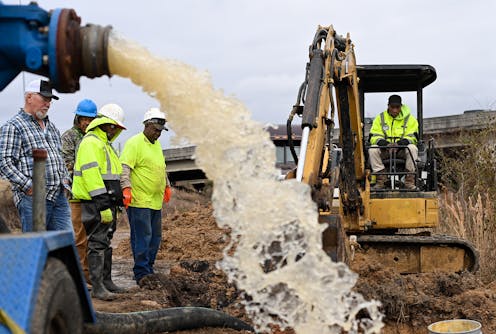The South’s aging water infrastructure is getting pounded by climate change – fixing it is also a struggle
- Written by Jonathan Fisk, Associate Professor of Political Science, Auburn University

Climate change is threatening[1] America’s water infrastructure as intensifying storms deluge communities[2] and droughts dry up freshwater supplies in regions that aren’t prepared.
The severe storms that swept through the South[3] April 10-11, 2024, illustrated some of the risks: In New Orleans, rain fell much faster[4] as the city’s pumps could remove it[5]. A water line broke[6] during the storm near Hattiesburg, Mississippi. Other communities faced power outages and advisories to boil water for safety[7] before using it.
We study infrastructure[8] resilience[9] and sustainability[10] and see a crisis growing[11], particularly in the U.S. Southeast, where aging water supply systems and stormwater infrastructure are leaving more communities at risk[12] as weather becomes more extreme.
Neighborhoods across the New Orleans area flooded on April 10 as the region’s pumps couldn’t keep up with the rainfall. Credit: Reed Timmer.To find the best solutions and build resilient infrastructure, communities need to recognize both the threats in a warming world and the obstacles to managing them.
What a water crisis looks like
Water crises can be caused by either too much or too little water, and they can challenge drinking water systems in unexpected ways.
For much of the past decade, parts of northern and central Alabama have experienced significant droughts[13]. In addition, wells dug to provide water have run dry[14], as water tables dropped from a combination of drought and overuse.
New Orleans’ water supply was threatened by drought in another way in 2023: Saltwater[15] from the Gulf of Mexico intruded farther than normal up the Mississippi River because the river’s flow had slowed.
At the same time, torrential rain events increasingly have overwhelmed stormwater systems[16] and threatened drinking water supplies. As global temperatures rise, the oceans heat up[17], and that warmer water provides more moisture to feed powerful storms[18].
An example of how extreme the situation can get has been playing out in Jackson, Mississippi, a city of nearly 150,000 residents. Jackson’s water system had been plagued with leaks and pipe breaks for over a decade before 2022, when intense flooding overwhelmed the system[20], leaving most residents with little or no water for days.
Even before the flood[21], Jackson residents had been advised to boil their water[22] before drinking it. Repairs are now underway with the aid of US$800 million in federal tax dollars[23], but questions remain[24] about how to keep the system maintained in the future. The April storm hit the region again with damaging winds, rain and power outages[25].
The fragility of aging water infrastructure is evident in many communities. The American Society of Civil Engineers’ U.S. Infrastructure Report Card[26] in 2021 estimated that a water main breaks every two minutes somewhere in the U.S., losing 6 billion gallons of treated water a day. The engineers gave U.S. municipal water systems overall a grade of C-minus.
Flood protection infrastructure earned even lower grades: U.S. levees and dams both received D grades, along with a warning that expanding development means more people and property are downstream and relying on levees and dams to function.
Challenge 1: Many stakeholders; who decides?
Today’s infrastructure ranges from brick and mortar facilities to electronic networks – each with varying needs, goals, responsibilities and vulnerabilities to climate change[27].
Moreover, infrastructure often functions interdependently. If one asset fails, such as a pipeline or the computer system that controls a water treatment plant, the damage can cascade to other systems. For example, untreated wastewater discharged into a stream because of a system failure can affect drinking water supplies for communities downstream.
Water issues cut across different levels of government, laws and regulations, and technical and academic expertise, requiring partnerships that can be difficult to govern. That can put different government agencies into conflict as disputes develop over regulatory control and responsibility, particularly between federal, state and local governments.
Challenge 2: Past decisions affect future choices
In many areas, water infrastructure built over the centuries has shaped subsequent development decisions, available resources and land use patterns, including the location of new homes, transportation facilities and businesses.
Today, that infrastructure may also be threatened by climate change[28] in ways its developers never imagined.
More intense rainfall events have made long-standing flood maps obsolete in some areas, and areas never considered at risk of flooding before are now flooding regularly[29]. This is especially true in coastal areas[30] where storms may be coupled with abnormally high tides, sea level rise and subsidence.
Challenge 3: Who pays?
Questions about who pays for infrastructure improvements, or who decides project priorities, can also generate conflict.
Infrastructure is expensive. A single project, such as replacing water pipes or a treatment facility, will involve significant design and construction costs, as well as maintenance and repairs that many poorer communities struggle to afford.
The American Society of Civil Engineers in 2021 estimated the difference between infrastructure investments of all types needed over the decade of the 2020s ($5.9 trillion) and infrastructure work planned and funded ($3.3 trillion) was $2.6 trillion[31]. It expects the annual gap for just drinking water and wastewater investment to be $434 billion by 2029.
Building new, climate-resilient infrastructure is beyond the financial capacity of many communities, particularly low-income communities[33].
The federal government has taken steps to provide more aid in recent years. The Bipartisan Infrastructure Law[34], passed in 2021, authorized $55 billion for drinking water, wastewater, water storage and water reuse projects. The Inflation Reduction Act[35], passed the following year, included $550 million to assist disadvantaged communities with water supply projects.
But those funds don’t close the gap, and political pressure to reduce federal spending[36] makes the future of federal support for infrastructure uncertain.
What can communities do?
Local communities, states and federal agencies need to reexamine the growing threats from aging infrastructure in a warming world and find new solutions. That doesn’t just mean new engineering designs – it means thinking differently about governance, planning and financing, and societal goals.
Fixing water challenges might mean rebuilding infrastructure[37] away from the threat, or building defenses against flooding. Some communities are experimenting with sponge landscapes and restoring wetlands[38] to create natural environments that absorb excess rainfall to reduce flooding.
The challenge is not just which engineering solution to choose, but how to navigate the responsibilities of actually providing clean water to Americans as the climate continues to change.
References
- ^ threatening (doi.org)
- ^ deluge communities (nca2018.globalchange.gov)
- ^ swept through the South (www.accuweather.com)
- ^ fell much faster (www2.swbno.org)
- ^ pumps could remove it (www.swbno.org)
- ^ water line broke (www.wdam.com)
- ^ advisories to boil water for safety (www.cbs19.tv)
- ^ infrastructure (scholar.google.com)
- ^ resilience (scholar.google.com)
- ^ sustainability (scholar.google.com)
- ^ crisis growing (doi.org)
- ^ leaving more communities at risk (doi.org)
- ^ significant droughts (www.routledge.com)
- ^ have run dry (www.onegreenplanet.org)
- ^ threatened by drought in another way in 2023: Saltwater (theconversation.com)
- ^ have overwhelmed stormwater systems (doi.org)
- ^ the oceans heat up (climatereanalyzer.org)
- ^ more moisture to feed powerful storms (doi.org)
- ^ Brad Vest/Getty Images (www.gettyimages.com)
- ^ overwhelmed the system (www.thenation.com)
- ^ before the flood (theconversation.com)
- ^ boil their water (www.epa.gov)
- ^ US$800 million in federal tax dollars (mississippitoday.org)
- ^ questions remain (apnews.com)
- ^ power outages (www.wjtv.com)
- ^ U.S. Infrastructure Report Card (infrastructurereportcard.org)
- ^ vulnerabilities to climate change (www.cisa.gov)
- ^ threatened by climate change (nca2023.globalchange.gov)
- ^ flooding regularly (www.pewtrusts.org)
- ^ in coastal areas (theconversation.com)
- ^ $2.6 trillion (infrastructurereportcard.org)
- ^ AP Photo/Mic Smith (newsroom.ap.org)
- ^ particularly low-income communities (www.al.com)
- ^ Bipartisan Infrastructure Law (www.phmsa.dot.gov)
- ^ Inflation Reduction Act (uswateralliance.org)
- ^ political pressure to reduce federal spending (www.nytimes.com)
- ^ rebuilding infrastructure (theconversation.com)
- ^ sponge landscapes and restoring wetlands (smartwatermagazine.com)
Authors: Jonathan Fisk, Associate Professor of Political Science, Auburn University



